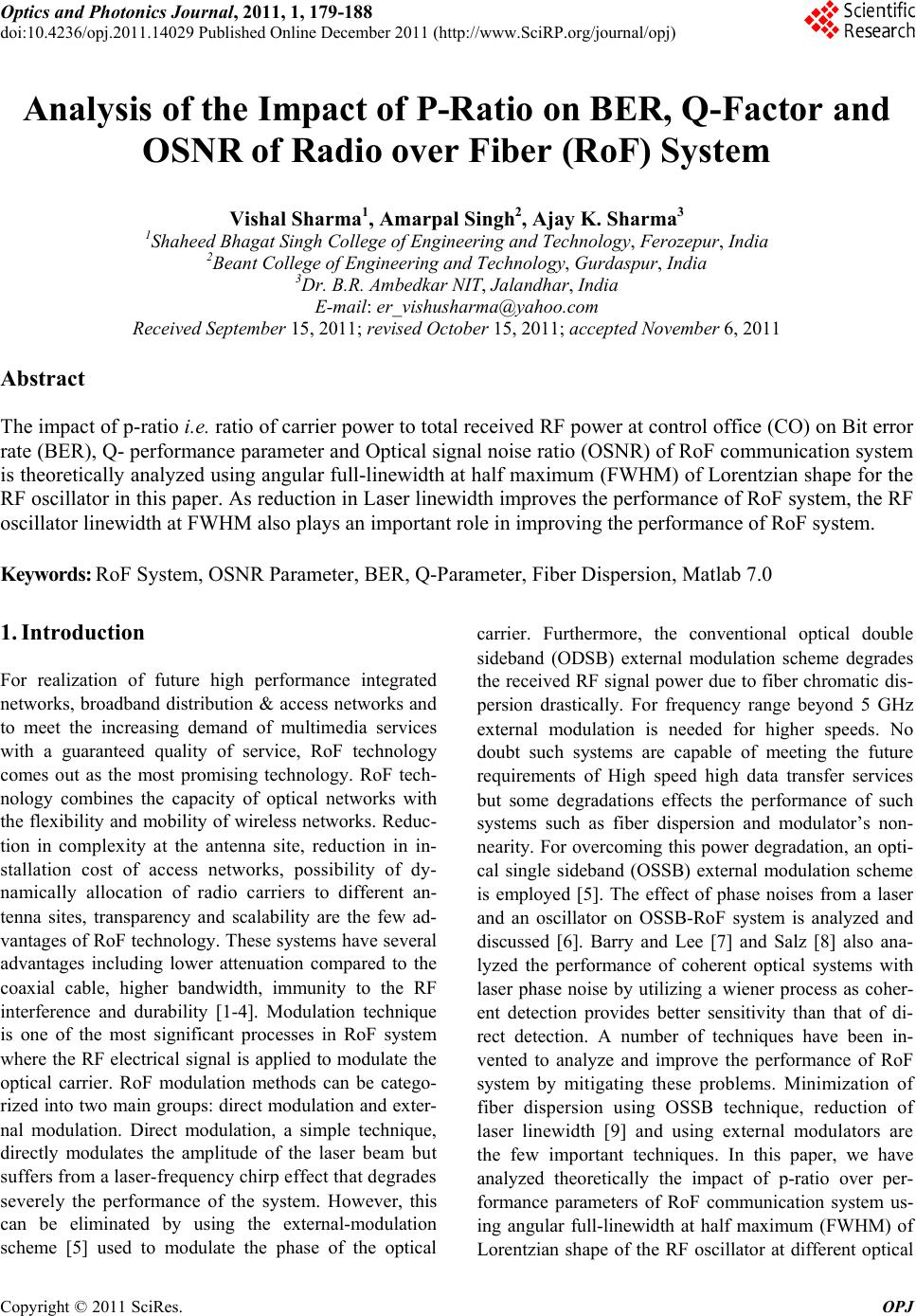
Optics and Photonics Journal, 2011, 1, 179-188
doi:10.4236/opj.2011.14029 Published Online December 2011 (http://www.SciRP.org/journal/opj)
Copyright © 2011 SciRes. OPJ
Analysis of the Impact of P-Ratio on BER, Q-Factor and
OSNR of Radio over Fiber (RoF) System
Vishal Sharma1, Amarpal Singh2, Ajay K. Sharma3
1Shaheed Bhagat Singh College of Engineering and Technology, Ferozepur, India
2Beant College of Engineering and Technology, Gurdaspur, India
3Dr. B.R. Ambedkar NIT, Jalandhar, India
E-mail: er_vishusharma@yahoo.com
Received September 15, 2011; revised October 15, 2011; accepted November 6, 2011
Abstract
The impact of p-ratio i.e. ratio of carrier power to total received RF power at control office (CO) on Bit error
rate (BER), Q- performance parameter and Optical signal noise ratio (OSNR) of RoF communication system
is theoretically analyzed using angular full-linewidth at half maximum (FWHM) of Lorentzian shape for the
RF oscillator in this paper. As reduction in Laser linewidth improves the performance of RoF system, the RF
oscillator linewidth at FWHM also plays an important role in improving the performance of RoF system.
Keywords: RoF System, OSNR Parameter, BER, Q-Parameter, Fiber Dispersion, Matlab 7.0
1. Introduction
For realization of future high performance integrated
networks, broadband distribution & access networks and
to meet the increasing demand of multimedia services
with a guaranteed quality of service, RoF technology
comes out as the most promising technology. RoF tech-
nology combines the capacity of optical networks with
the flexibility and mobility of wireless networks. Reduc-
tion in complexity at the antenna site, reduction in in-
stallation cost of access networks, possibility of dy-
namically allocation of radio carriers to different an-
tenna sites, transparency and scalability are the few ad-
vantages of RoF technology. These systems have several
advantages including lower attenuation compared to the
coaxial cable, higher bandwidth, immunity to the RF
interference and durability [1-4]. Modulation technique
is one of the most significant processes in RoF system
where the RF electrical signal is applied to modulate the
optical carrier. RoF modulation methods can be catego-
rized into two main groups: direct modulation and exter-
nal modulation. Direct modulation, a simple technique,
directly modulates the amplitude of the laser beam but
suffers from a laser-frequency chirp effect that degrades
severely the performance of the system. However, this
can be eliminated by using the external-modulation
scheme [5] used to modulate the phase of the optical
carrier. Furthermore, the conventional optical double
sideband (ODSB) external modulation scheme degrades
the received RF signal power due to fiber chromatic dis-
persion drastically. For frequency range beyond 5 GHz
external modulation is needed for higher speeds. No
doubt such systems are capable of meeting the future
requirements of High speed high data transfer services
but some degradations effects the performance of such
systems such as fiber dispersion and modulator’s non-
nearity. For overcoming this power degradation, an opti-
cal single sideband (OSSB) external modulation scheme
is employed [5]. The effect of phase noises from a laser
and an oscillator on OSSB-RoF system is analyzed and
discussed [6]. Barry and Lee [7] and Salz [8] also ana-
lyzed the performance of coherent optical systems with
laser phase noise by utilizing a wiener process as coher-
ent detection provides better sensitivity than that of di-
rect detection. A number of techniques have been in-
vented to analyze and improve the performance of RoF
system by mitigating these problems. Minimization of
fiber dispersion using OSSB technique, reduction of
laser linewidth [9] and using external modulators are
the few important techniques. In this paper, we have
analyzed theoretically the impact of p-ratio over per-
formance parameters of RoF communication system us-
ing angular full-linewidth at half maximum (FWHM) of
Lorentzian shape of the RF oscillator at different optical